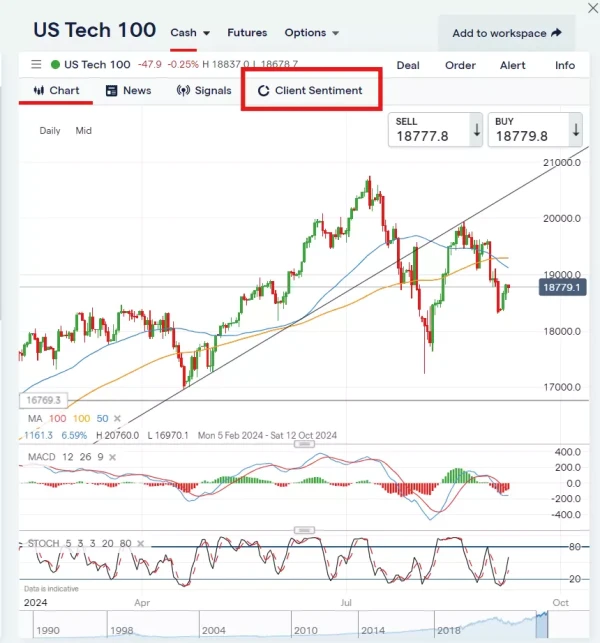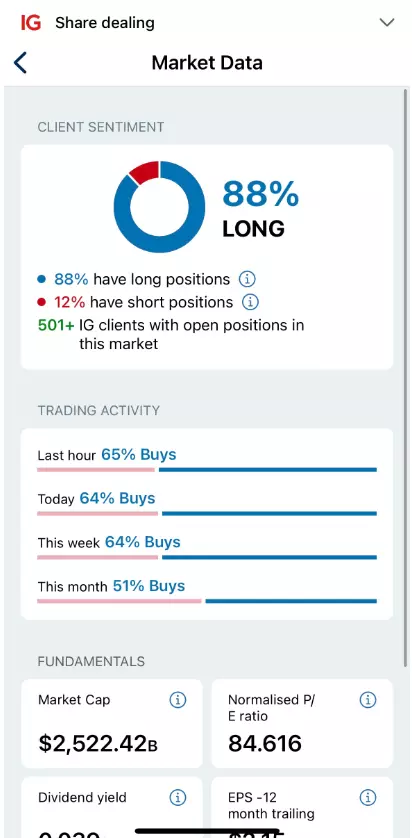How to trade using IG client sentiment
What is market sentiment?
Market sentiment represents the overall attitude of investors toward a particular security or financial market. It's a powerful tool that can help traders capitalise on changing market directions. Understanding and effectively trading market sentiment can give investors an edge in their decision-making process.
At its core, market sentiment reflects the mood of financial markets and the general feeling among traders. It can be described as either bullish, when the market is optimistic and expects prices to rise, or bearish, when the market is pessimistic and expects prices to fall.
Sentiment is influenced by various factors and is demonstrated through price movements. By understanding sentiment, traders can gauge whether a market is feeling optimistic or pessimistic about the future prices of a security.
The role of emotions in market sentiment
Two primary emotions drive market sentiment: fear and greed. Greed can lead to buying overpriced securities as positive sentiment snowballs, while fear can cause knee-jerk reactions, often leading to selling at a loss.
Recognising when fear or greed has taken over can help identify market turning points, providing savvy traders with opportunities to capitalise on market inefficiencies.
Using IG client sentiment and where to find it
IG client sentiment can provide a useful aid to trading financial markets. Our client sentiment looks at the overall positioning of IG clients in a market, in other words how many are long and how many are short.
This is then translated into a sentiment reading, using percentages. Note that this looks at the number of positions overall, and does not take into account the size of those positions.
It is also broken down into trading activity, in four different time frames, looking at the past hour, the current day, the current week and the current month. This helps to provide a more granular view over various time frames.
To find this data in our trading platform, select a market and then open the ‘Client Sentiment’ tab above the price chart, as shown below:

On opening the tab, you will see the client sentiment wheel, and the four time frames:

In the mobile app, the information can be found in the ‘Market Data’ tab, as shown below:

Ready to get started? Open an account with us today, or practise with a demo.
Strategies for trading market sentiment
To effectively trade market sentiment, it's crucial to use these sentiment indicators alongside technical and fundamental analysis. Traders should look for divergences between sentiment and price action, as these can often signal potential reversals.
Being aware of extreme sentiment levels is also important, as these often precede market reversals. In stock markets, monitoring volume changes can provide additional insight into the strength of sentiment. Staying informed about news and developments that could shift market mood is also essential for sentiment-based trading.
Integrating sentiment analysis into your trading approach
While sentiment is a crucial factor in market movements, it should be just one aspect of a broader trading strategy. Combining sentiment analysis with solid technical and fundamental analysis typically yields the best results.
Traders should remember that markets are complex systems influenced by numerous factors, and sentiment is just one piece of the puzzle.
Market sentiment summed up
Market sentiment is a powerful force that drives financial markets. By understanding the emotions behind market movements, using appropriate tools to measure sentiment, and incorporating this knowledge into a comprehensive trading strategy, investors can better position themselves to capitalise on market trends and potential reversals.
However, it's important to approach sentiment analysis with a balanced perspective, using it as one of many tools in the trader's toolkit rather than relying on it exclusively.